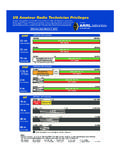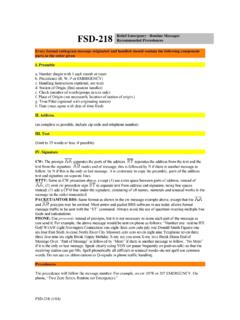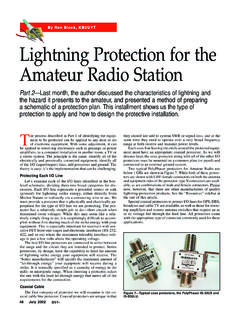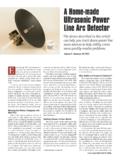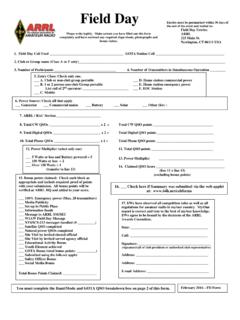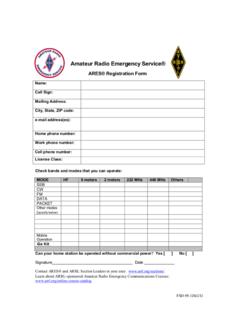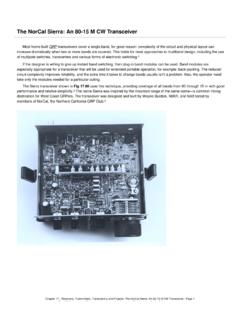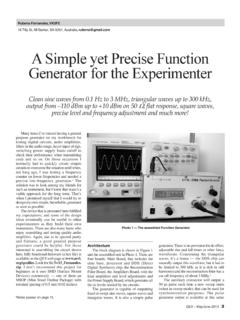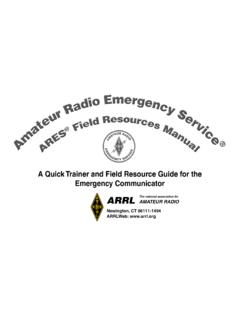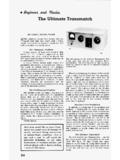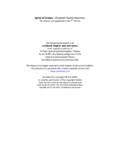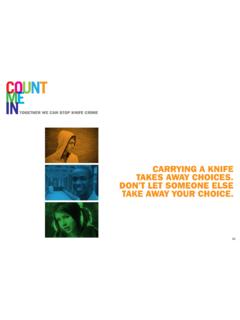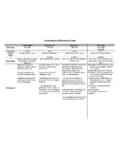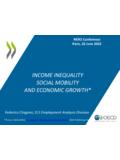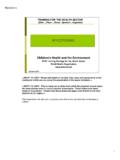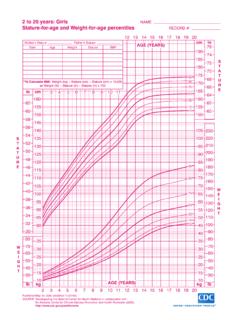Transcription of Light Bulbs and RFI — A Closer Look
1 Reprinted with permission from October 2013 QST arrl , the national association for Amateur Radio Mike Gruber, W1 MGSince its invention by Thomas Edison in 1879, the Light bulb has had a truly dramatic and profound impact on modern society. Despite its effect on our daily lives, most of us probably take the Light bulb for granted. But as many of us already know, Mr. Edison s incandescent Light bulb is now being phased out in favor of more energy efficient alterna-tives, in part driven by new government re-quirements. These changes have sparked particular interest among some amateurs who are concerned about the potential for interfer-ence that the new Bulbs may US government s new energy efficiency standards, which were implemented in 2012, require a lighting technology that is roughly 30% more efficient than the incandescent Light bulb. Modern energy saving Bulbs , how-ever, typically contain electronic circuitry.
2 This circuitry has the potential to generate RF, and with it, the possibility of interference to nearby radio receivers, including amateur receivers. So far, most energy saving drop-in replace-ment Bulbs have been one of two types compact fluorescent lights (CFLs) and Light emitting diode (LED) Bulbs . While the newer LED Bulbs seem to be gaining in market popularity, both types of Bulbs can contain electronics capable of causing The FCC SaysTwo sets of rules apply for these new Bulbs in a residential environment. LED Bulbs op-erate under Part 15 of the FCC rules. Typically, they are classified as an uninten-tional radiator, if their internal circuitry is operating at greater than 9 kHz. See Table 1A for the specified FCC limits. If at less than 9 kHz, the bulb would still operate under Part 15 but as an incidental radiator. In this case, there would be no specified emissions limits, just a requirement not to cause harmful interference.
3 Since incandes-cent Bulbs do not intentionally generate RF, they are also classified as incidental of Many PartsMany people are surprised to learn that CFL Bulbs , and electronic ballasts for fluorescent Light ballasts for that matter, do not operate under Part 15. Rather, these devices typically operate under Part 18, which addresses Light Bulbs and RFI A Closer LookNew high efficiency Light Bulbs put out plenty of Light , but hams wonder what , Scientific and Medical (ISM) de-vices. Some household and consumer de-vices, however, also fall under Part 18. These devices convert RF energy above 9 kHz di-rectly into some other form of energy such as Light , heat or ultrasonic sound. While CFL Bulbs and electronic fluorescent Light ballasts are two common examples, there are others, including microwave ovens and some ultra-sonic jewelry 18 has two sets of limits for Bulbs consumer and non-consumer RF lighting de-vices.
4 The emissions limits are considerably lower for consumer rated Bulbs . Consumer rated Bulbs are the only Bulbs that should be used for residential applications. See Tables 1B and 2B as well as the sidebar Part 18 Consumer versus Non Consumer Ballasts for the applicable Part 18 manufacturers are required to meet the applicable limits for a bulb, it s important to understand that these limits are high enough that interference can still occur to nearby re-ceivers in some cases. Should this occur, however, both Parts 15 and 18 have an addi-tional provision against harmful interference. The burden in this case then falls on the op-erator of the device, in this case the Light fix-ture operator not the manufacturer to correct the problem. What the Rules MeanIn a nutshell, manufactures of these new Bulbs are required to meet certain specified emissions limits. Bulb operators must cor-rect any interference that the device might cause, including a provision to cease using the device upon notification by an agent of the FCC.
5 Typically, this means the ham who uses these Bulbs , or a nearby neighbor with a noisy bulb, is ultimately responsible for fix-ing any interference problems caused by the bulb. The applicable rules are perhaps best summarized by the ubiquitous Part 15 label that comes with all unintentional radiators, including LED Bulbs . Part 18 also has a re-quirement for similar labeling:This device complies with part 15 of the FCC Rules. Operation is subject to the following two conditions: (1) This device may not cause harmful interference, and (2) this de-QST Devoted entirely to Amateur Radio OReprinted with permission from October 2013 QSTvice must accept any interference received, including interference that may cause unde-sired notable exception to this rule involves interference from a Part 18 device (such as a CFL) in an ISM band. When amateur spec-trum falls in an ISM band, such as the entire 902 MHz band, and parts of the GHz band, interference from a Part 18 device must be tolerated.
6 Amateur Radio is not protected under the rules in this case. Fortunately, in the case of Light Bulbs , this has not been an issue, at least not one that has so far been re-ported to the Emissions TestingBoth Part 15 and 18 specify two types of emissions limits. Above 30 MHz, they spec-ify a field strength limit for direct radiation from the bulb itself. Below 30 MHz, how-ever, they only specify conducted emissions limits. At HF and lower frequencies, Bulbs (and most consumer devices) are simply too small to act as an efficient antenna. In this case, the device generates the RF, which is 1 Notes appear on page 45. The FCC Conducted Emissions LimitsRadio frequency voltage conducted back onto the ac power line (on any frequency or frequencies) by lighting equipment designed to be connected to the public utility (ac) power line shall not exceed the limits in the following tables. These limits are based on the measurement of the radio frequency voltage between each power line and ground at the power terminal using a 50 H/50 W line imped-ance stabilization network (LISN).
7 Table 1 APart 15B Conducted Emissions Limits (For Unintentional Radiators, such as LED Lighting)Frequency of Conducted emission (MHz) limit (dB V) Quasi-peak 66 to 56* 56 to 46* 56 465-30 60 50*Decreases with the logarithm of the 1 BPart 18 Conducted Emissions Limits (For RF Lighting Devices, such as CFLs and Electronic Fluorescent Light Ballasts) Maximum RF line voltage measured Frequency with a 50 uH/50 ohm Conducted (MHz) LISN ( V) limit (dB V)Consumer to 250 to 3000 to 30 250 48 Nonconsumer 1000 3000 70then conducted by the power cord, or the connection to the house wiring. The house wiring then acts as an antenna to radiate the RF. The RF can also be conducted by power lines out to the street, resulting in the power distribution wires also radiating the unwanted noise.
8 Based on practical real world experi-ence, most HF interference problems to Amateur Radio are caused by conducted shown by Table 1A, the Part 15 limits for conducted emissions are expressed in dB V, or dB relative to 1 V. The FCC also speci-fies that these measurements be made be-tween each power line and ground at the power terminal using a 50 H / 50 W line im-pedance stabilization network, commonly re-ferred to as a LISN. A LISN is essentially a filter that separates the RF voltage to be mea-sured from the 60 Hz power frequency. The FCC also specifies that measurements be made using quasi-peak See the April 2009 issue of QST, page 48 for addi-tional discussion concerning Part 15 con-ducted emission level arrl Lab Test FacilitySeveral years ago, the arrl Lab construc-ted a room for conducted emissions testing per ANSI Standard In order to make such measurements to ANSI standard specifications, a LISN and special receiver are required and, in addition, a ground plane on the floor and back wall of specified di-mensions are required.
9 The standard also specifies dimensions for a non-conducting test bench, plus detail on product configura-tion, test layout and so forth. This level of detail ensures test repeatability with uniform and universal results. It was a lot of work, but it gave the arrl Lab the ability to reason-ably measure some consumer products, in-cluding Light Bulbs , for conducted emissions the SamplesOur objective was to select a wide variety of Bulbs , including CFL and LED products from a number of manufacturers. In the end, we tested 40 different Bulbs from many dif-ferent sources, including local retail outlets, online sources and hamfests. If applicable, we also tested each bulb in an insulated por-celain fixture and a grounded recessed metal fixture, for part of this program, we tested 7 CFL Bulbs , 30 LED Bulbs , a self-contained out-door Light LED lantern fixture and two traffic lights that we purchased at the Dayton Hamvention flea ResultsWe found that most brand name Bulbs sub-stantially met their limits within our mea-surement uncertainty.
10 Most of the issues that we found were below 500 kHz, and most of them were probably within our measurement uncertainty. We did see obvious problems as-sociated with those Bulbs purchased online directly from an overseas source. These Bulbs clearly did not meet FCC specifica-tions, and did not have the proper FCC label-ing. See the test data on the QST in Depth web page for all of our Figures 1-4 show representative samples of LED and CFL Bulbs tested that both passed and About the Real World?We tested a random sample of the Bulbs in a variety of fixtures in the home and shack of Senior arrl Lab Engineer Bob Allison, WB1 GCM. These tests included the fixtures we used for conducted emissions testing. In each case, we listened for noise with the station s ham receiver and a portable battery powered Sony ICF-2010 shortwave receiver. The portable radio allowed us to listen Reprinted with permission from October 2013 QST arrl , the national association for Amateur Radio QS1310-Gruber01100 kHz30 MHzFrequency 20020406080dB V15 MHzPASSF igure 1 Conducted emission spectrum from 0 to 30 MHz of an LED night Light bulb of unknown manufacture purchased from an Internet auction site.
